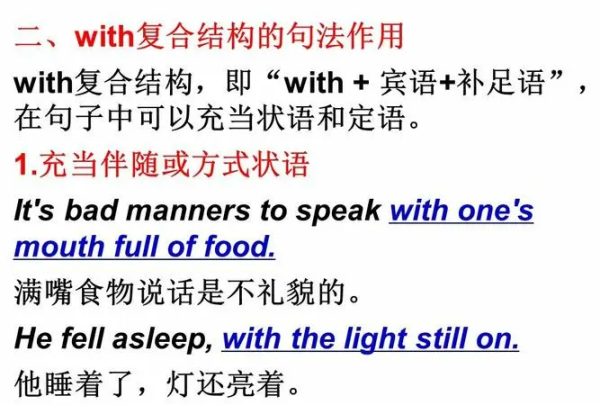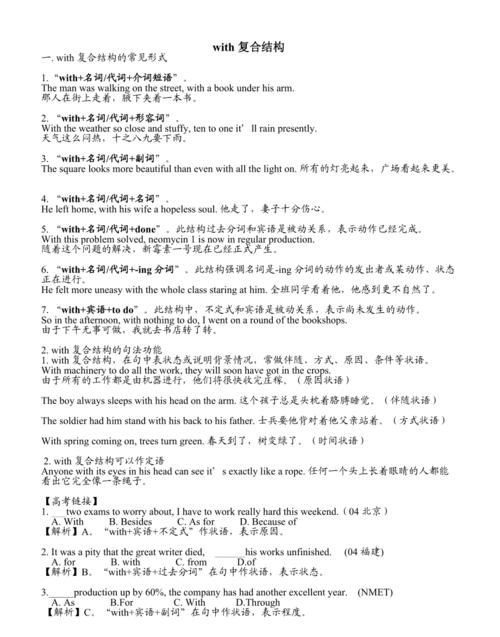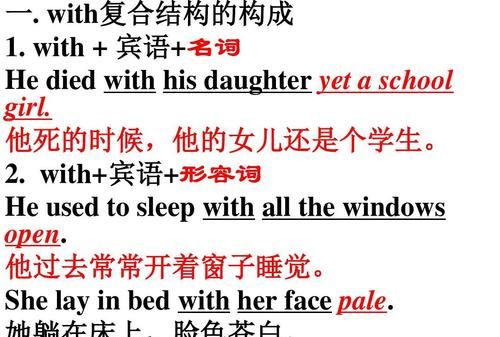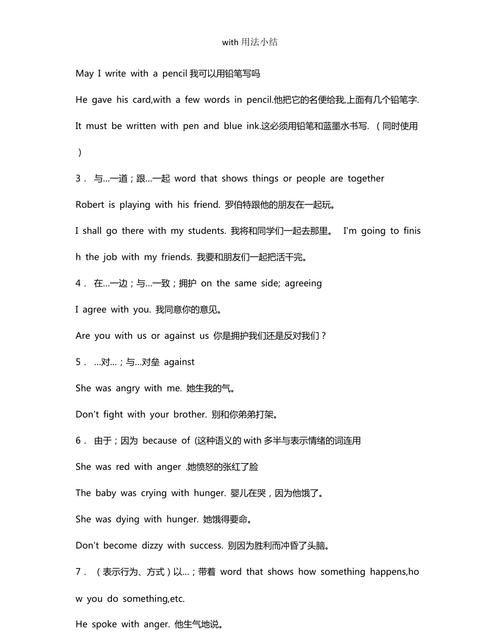本文目录
with的七种复合结构用法例句
with的8种复合结构用法例句如下所示:
1、with +宾语+名词
He died with his daughter a schoolgirl.他在他女儿是个小学生的时候死了。
2、with+名词(或代词)+补语
He wondered if he could slide out of the lecture hall without anyone noticing.他想他是否可以在没有人注意到他的情况下悄悄溜出演讲大厅。
3、with +名词(或代词)+过去分词
She had to walk home with her bike stolen.自行车被偷,她只好步行回家。
4、with +名词(或代词)+现在分词
With the crowds cheering, they drove to the palace.在人群的欢呼声中,他们驱车来到皇宫。

5、with+名词(或代词)+非谓语动词
With a lot of work to do, he wasn't allowed to go out.因为还有很多工作要做,他没有被允许外出。
6、with+名词(或代词)+介词短语
He walked into the dark street with a stick in his hand.他走进黑暗的街道时手里拿着根棍子。
7、with+名词(或代词)+副词
She left the room with all the lights on.她离开了房间,灯还亮着。
8、with+名词(或代词)+形容词
I like to sleep with the windows open.我喜欢把窗户开着睡觉。
have和has的区别和用法是什么意思
他的意思是和什么什么一起跟同和有带有用,一借助反对对立有什么什么负责,有什么什么处理,对对于为什么什么锁雇佣做为什么什么什成员受什么什么影响,表示与某物分离
用法是加名词再加介词短语
或者加名词加过去分词
再或者加名词,加现在分词

关于with的用法
with是常见的介词,有很多用法。 with的用法在英语学习中是比较重要的一个知识点,掌握重要知识点没有那么容易。接下来我在这里给大家带来with的用法,我们一起来看看吧!
with用法
1. 表示方式、手段或工具等时(=以,用),注意不要受汉语意思的影响而用错搭配,如“用英语”习惯上用in English,而不是with English。
2. 与某些抽象名词连用时,其作用相当于一个副词。如:
with care=carefully 认真地
with kindness=kindly 亲切地
with joy=joyfully 高兴地
with anger=angrily 生气地
with sorrow=sorrowfully 悲伤地
with ease=easily 容易地
with delight=delightedly 高兴地
with great fluency =very fluently 很流利地
3. 表示条件时,根据情况可与虚拟语气连用。如:
With more money I would be able to buy it. 要是钱多一点,我就买得起了。
With better equipment, we could have finished the job even sooner. 要是设备好些,我们完成这项工作还要快些。
4. 比较with和as:两者均可表示“随着”,但前者是介词,后接名词或代词;后者是连词,用于引导一个句子。比较:
He will improve as he grows older. 随着年龄的增长,他会进步的。
People’s ideas change with the change of the times. 时代变了,人们的观念也会变化。
5. with的复合结构 “with+宾语+宾语补足语”是一个很有用的结构,它在句中主要用作状语,表示伴随、原因、时间、条件、方式等;其中的宾语补足语可以是名词、形容词、副词、现在分词、过去分词、不定式、介词短语等。如:
(1) with+宾语+形容词
He often sleeps with the windows open. 他常开着窗睡觉。
Don’t speak with your mouth full. 不要满嘴巴食物说话。
(2) with+宾语+ 副词
He stood before his teacher with his head down. 他低着头 站在老师面前。
He was lying on the bed with all his clothes on. 他和衣 躺在床上。
(3) with +宾语+ 介词短语
She said good-bye with tears in her eyes. 她含着眼泪说了声再见。
The man was asleep with his head on his arms. 这个人头枕着胳膊睡着了。
(4) with+宾语+现在分词
He fell asleep with the lamp burning. 他没熄灯就睡着了。
I won’t be able to go on holiday with my mother being ill. 因为妈妈有病, 我无法去度假。
(5) with +宾语+ 过去分词
He sat there with his eyes closed. 他闭目坐在那儿。
All the afternoon he worked with the door locked. 整个下午他都锁着门在房里工作。
(6) with +宾语+ 动词不定式
I can’t go out with all these clothes to wash. 要洗这些衣服, 我无法出去了。
With such good cadres to carry out the Party’s policy we feel safe. 有这样的好干部执行党的政策, 我们感到放心。
(7) with +宾语+ 名词
He died with his daughter yet a schoolgirl. 他去世时,女儿还是个小学生。
with的用法例句
1 With her were her son and daughter-in-law
和她在一起的是她的儿子和儿媳。
2 Serve hot, with pasta or rice and French beans
趁热和意大利面或米饭以及四季豆一起端上桌。
3 Parents will be able to discuss their child's progress with their teacher
家长将可以和老师交流谈论子女的进步情况。
4 About a thousand students fought with riot police in the capital
大约1,000名学生在首都与防暴警察发生了冲突。
5 Remove the meat with a fork and divide it among four plates
用餐叉把肉叉走,分到4个盘里。
with和and的用法区别
with
①是介词,后边带名词、代词或相当于名词、代词的词作宾语,with sb./ sth.
②单数名词作主语带with时,谓语动词仍然是单数,如:
LiPing with Tom often goes to the park.
③它的汉意是:“和…一起,跟…一起”“和…,跟…”“在…一边,与…一致”“拥护…”“具有、带有”“在…身上”表示使用工具.
and
①是并列连词,并列同类的词或表示对称关系,并列词与词、词组与词组、句子与句子.
②两个单数名词用and连接作主语时,谓语动词用复数.
LiPing and Tom are students.
并列两个不可数名词(指不是同一种事物时),谓语动词用复数.
Air and water are important to us.
③它的汉意 和、与、及、同、又、并; 强调连续反复
talk and talk
连两比较级意为越来越.
More and morewith①是介词,后边带名词、代词或相当于名词、代词的词作宾语,with sb./ sth.
②单数名词作主语带with时,谓语动词仍然是单数,如:
LiPing with Tom often goes to the park.
③它的汉意是:“和…一起,跟…一起”“和…,跟…”“在…一边,与…一致”“拥护…”“具有、带有”“在…身上”表示使用工具.
and①是并列连词,并列同类的词或表示对称关系,并列词与词、词组与词组、句子与句子.
②两个单数名词用and连接作主语时,谓语动词用复数.
LiPing and Tom are students.
并列两个不可数名词(指不是同一种事物时),谓语动词用复数.
Air and water are important to us.
③它的汉意 和、与、及、同、又、并; 强调连续反复
talk and talk
连两比较级意为越来越.
More and more
with相关解释
prep. 随着; 和,跟; 关于; 和…一致;

to的六种用法例句
表示方式、手段或工具等时(=以,用),如:with a car 用卡车
2. 与某些抽象名词连用时,其作用相当于一个副词.如:
with care=carefully 认真地
with kindness=kindly 亲切地
3. 表示条件时,根据情况可与虚拟语气连用.如:
With more money I would be able to buy it. 要是钱多一点,我就买得起了.
With better equipment, we could have finished the job even sooner. 要是设备好些,我们完成这项工作还要快些.
4. 比较with和as:两者均可表示“随着”,但前者是介词,后接名词或代词;后者是连词,用于引导一个句子.比较:
He will improve as he grows older. 随着年龄的增长,他会进步的.
People’s ideas change with the change of the times. 时代变了,人们的观念也会变化.
5. 复合结构“with+宾语+宾语补足语”是一个很有用的结构,它在句中主要用作状语,表示伴随、原因、时间、条件、方式等;其中的宾语补足语可以是名词、形容词、副词、现在分词、过去分词、不定式、介词短语等.如:
(1) with+宾语+形容词
He often sleeps with the windows open. 他常开着窗睡觉.
Don’t speak with your mouth full. 不要满嘴巴食物说话.
(2) with+宾语+ 副词
He stood before his teacher with his head down. 他低着头 站在老师面前.
He was lying on the bed with all his clothes on. 他和衣 躺在床上.
(3) with +宾语+ 介词短语
She said good-bye with tears in her eyes. 她含着眼泪说了声再见.
The man was asleep with his head on his arms. 这个人头枕着胳膊睡着了.
(4) with+宾语+现在分词
He fell asleep with the lamp burning. 他没熄灯就睡着了.
I won’t be able to go on holiday with my mother being ill. 因为妈妈有病, 我无法去度假.
(5) with +宾语+ 过去分词
He sat there with his eyes closed. 他闭目坐在那儿.
All the afternoon he worked with the door locked. 整个下午他都锁着门在房里工作.
(6) with +宾语+ 动词不定式
I can’t go out with all these clothes to wash. 要洗这些衣服, 我无法出去了.
With such good cadres to carry out the Party’s policy we feel safe. 有这样的好干部执行党的政策, 我们感到放心.
(7) with +宾语+ 名词
He died with his daughter yet a schoolgirl. 他去世时,女儿还是个小学生.

以上就是关于with的用法及例句 ,with的七种复合结构用法例句的全部内容,以及with的用法及例句 的相关内容,希望能够帮到您。
